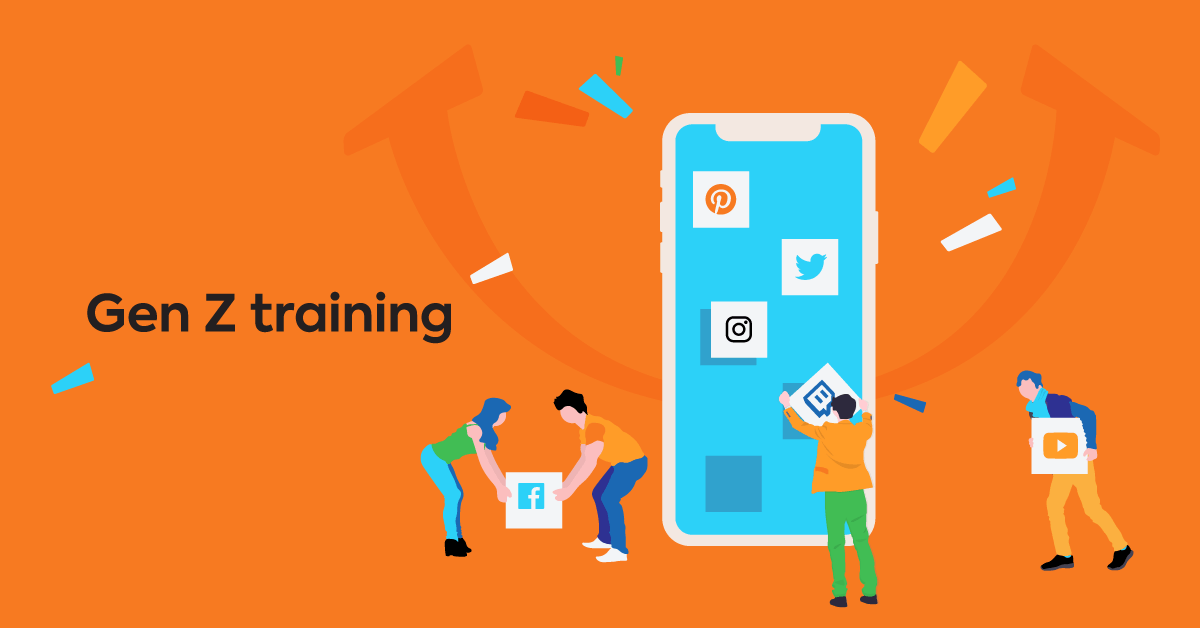At age 24, the oldest Gen Z’s are just beginning their careers, but the time to get ready for them is now. They are very different from previous generations — even their nearest neighbor, the millennials — and their expectations when it comes to career and education are equally diverse. This means that training Gen Z employees will require a different approach, too.
Over sixty million members of Gen Z are poised to enter the workplace in the next few years. Gen Z is about to transform your work habits and your employee training. Here is what you need to know.
Who is Gen Z?
The Pew Research Center defines Generation Z as anyone born after 1996. They are the most racially diverse and well-educated group in the US. Diversity is part of their DNA, but so is technology.
Gen Z has never known a world without the internet. They’re true digital natives, and because of this, technology alone does not wow them. They expect it to do its job and they’ll get frustrated and impatient with outdated or dysfunctional software, and any training that uses that type of tech.
Mark Perna discusses all about Gen Z in Unlocking Gen Z’s full potential in the workplace. He claims that, unlike millennials, Gen Zers tend to define themselves by their work and are willing to do whatever it takes to get ahead. This is why they are viewed as the benchmark generation.

Money and career success drive Gen Z more than friendships, marriage, or even travel. However, although they are true digital natives, they also deeply value face-to-face contact.
What does this mean for your Generation Z training programs?
It means a quantum shift that incorporates the latest technologies and innovations in training but also fulfills that desire for human contact. Your Gen Z training must acknowledge that while these new workers crave information, they also know how to find answers. They’ll be easily distracted if your training isn’t informative and engaging.
Here are a few tips to help you build a successful Gen Z training program:
1. Engage through cross-training
To engage learners, Gen Z training has to do more than match a job description. Gen Zers have been preparing for jobs that don’t yet exist. They want to continue to accumulate a variety of skills that bridge the gaps between your verticals and teams. Offer training that extends their capabilities. For example, provide your software engineers with marketing training, and your data people with sales skills.
Cross-training also fits perfectly into a future of work that is going to require L&D to upskill and reskill employees and perform quick pivots. Essentially, the type of diverse training programs that Gen Z demands will prepare your entire workforce for what’s to come. They’ll be more flexible, adaptable, and better positioned for the future.
2. Use videos for storytelling
Gen Z loves Instagram and Snapchat, while TikTok has also become one of their favorite apps. On average, they watch 68 videos each day. That means Gen Z training has to be visual. Videos are especially useful for Gen Z online training, particularly when it comes to how-to and instructional videos.
But not all videos are created equal. This is the generation of TikTok and short videos which get to the point fast. Before you set up your own company YouTube channel or create a collection of training videos, here are a few tips for ensuring your videos do the trick for training Gen Z:
- Create quick, instructional videos that get straight to the point
- Ensure videos are relevant and avoid fluff and filler
- Add a humorous touch (when appropriate) to engage
- Leverage strong imagery and animation
- Consider professional production (Gen Z recognizes and appreciates quality multimedia)
Create rich online courses with TalentLMS
The training platform that users consistently rank #1.
Easy to set up, easy to use, easy to customize.
3. Create immersive learning experiences
Gen Z is not a passive learner generation, so training can’t be passive either. They’re independent and adept at getting the answers for themselves, and they want hands-on training they can fully immerse themselves in. That means something that mimics hands-on training.
There are many ways you can create an immersive experience in your Generation Z online training. Here are a few ideas:
- 360-degree videos
- Simulations
- Game-based learning
- AR/VR Augmented Reality
4. Leverage bite-sized learning
The real challenge of training Gen Z will be capturing and keeping their attention. Used to switching between no less than five devices (smartphone, TV, laptop, desktop, and tablet) and spending 6 to 9 hours per day consuming entertainment media content, you’ll have to work hard for that attention.
Microlearning can help. Deliver learning in quick, tightly focused bites that can be consumed in minutes rather than hours. This type of training feeds both the Gen Z need for instant information and their wavering attention span.
Additional benefits of microlearning for Gen Z are that the training content:
- Is available any time, from anywhere
- Supports various media types
- Can be consumed on a mobile device, on the go
Meet TalentLibrary™
A growing collection of ready-made courses that cover the soft skills
your teams need for success at work![]()

5. Take it mobile
Gen Z might use multiple devices and switch screens often, but their smartphones are where they really live. According to one study, 98% of Gen Z own a smartphone.
The message for you? Bring your training where Gen Z is. It’s not enough, though, to just make your content available for mobile devices. Build courses with a mobile-first design. You’ll lose your Gen Z learners if your mobile training is slow to load or requires endless scrolling. To ensure your mobile learning does the trick and both engages and trains your Gen Z employees:
- Pare down your content
- Ensure information is relevant and up-to-date
- Design for clarity and conciseness
- Keep navigation simple
- Apply microlearning strategies
- Incorporate social media and interaction
6. Allow for self-paced learning
The best way to train Gen Z? Provide learning opportunities and let them explore them on their own. This is the Google Generation. They know where to look when they need to know something. Leverage this skill in your Gen Z training. These learners will thrive when they have the independence to direct their training and forge their own learning paths.
Self-paced learning accommodates the Gen Z desire for autonomy. Gen Zers crave knowledge and are truly lifelong learners. Besides mandatory training (e.g. new hire or compliance training), make sure to offer a library of optional courses where employees can pick training based on their preferences.

7. Personalize learning
Adaptive learning is a technique that uses AI technology to pivot learning to quickly address the needs of the end-user. For Gen Z this means less time wasted on training they don’t need and more opportunities for targeted training.
Algorithms detect and adjust learning to ignore what the user already knows, and focus instead on what they still need to master. These algorithms can also see when a learner needs remedial help and then seamlessly deliver it.
Using AI software, you can increase the level of difficulty when a learner knows their stuff or follow up when they don’t. With the right LMS reports, you can also identify areas for improvement on an individual or team-level and deliver training or additional material that will help cover specific skills gaps, as opposed to repeating the same courses.
8. Add a human touch to your training
Digital natives they might be, but Gen Z appreciates human connections, and they are masters at networking. Many of them (72%), actually prefer face-to-face communication at work. Even if your training is fully remote, try to create opportunities for collaboration and networking through virtual meetups and web conferences.
Gen Z sees virtual environments as a natural way to extend their relationship with others, and so should you. Mentorship programs, either in-person or virtual, could help connect younger generations with your more experienced workforce.
Here are a few other ways you can incorporate the human touch into your Gen Z training:
- Case competitions and hackathons
- Role-playing activities
- Design challenges
- Live discussion groups
- Team open chats
Conclusion
Gen Z is the benchmark generation as Mark Perna supports. And in fact, they set a universal standard for engaging across all ages. How? By prioritizing human connection, lifestyle over career, and the expectation of immediate respect. Understanding and adapting to their values and behaviors leads to improved talent management, engagement, and social integration.

Training Gen Z is a challenge but meeting that challenge can have tremendous payoffs for your entire workforce and the growth of your company. Adjusting your training to meet the needs of Gen Z won’t just engage your Gen Z employees, it will help your organization prepare to be a workplace of the future.
| Tags: Employee Training,Learner Engagement



![Etiquette Training: 12 Rules For Crafting Professional Emails [+Free Guide]](https://images.www.talentlms.com/blog/wp-content/uploads/2023/03/TLMS_20230228_1200x628.png)